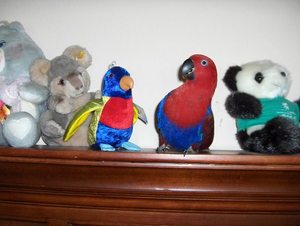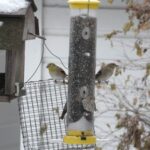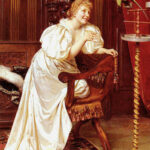If you’ve ever stood in the same room with one of these birds then you understand the reason many people would want to jump right into and get one as a pet. This is not an entirely uncommon breed in the parrot world but they aren’t as often seen as some of the more available Amazons and African Grays.
There are several different subspecies of Eclectus including Solomon Island, Grande and Vos Maeri Eclectus, among others. Most of them are fairly similar in appearance, varying a bit in size and slight changes in coloration. The males are often covered in bright green hair-like feathers with a large candy corn colored upper beak. Their wings often have shades of red and blue that are hidden unless the wings are spread or drooped. Females are completely different in coloration. The difference is so great that in the past, the two were thought to be of completely different breeds of birds. Only recently, within the past several decades, did it come to be discovered that these are indeed the same breed of bird; they are just very different in coloring between the sexes, or sexually dimorphic. The coloration on the females is generally a very deep bright red on the head and neck. The chest and lower part of the body ranges from a deep lavender to a dark purple, with wings a shade of burgundy. Depending on the type of Eclectus, there may or may not be a bright blue ring directly around the eye. Female birds have a large black upper and lower beak.
As far as temperament goes, it has been reported to vary quite a bit between males and females. The breed overall is a fairly independent breed. It’s not a breed that will typically scream and cry for attention or bed for an hour of cuddling like a Cockatoo might do. While some of these birds do enjoy affection and cuddling, they are more likely to enjoy spending time with you sitting on your arm or lap watching a bit of television or playing on the play gym. Male Eclectus owners often state the birds are very loving, rarely nip or bite, and are easy to get along with and train. Female Eclectus owners state their birds are more likely to nip, are a bit bossier and have a more stubborn air about them. Being a female Eclectus owner myself, I can vouch for this as well. While I’ve not owned a male, I have worked with a few and, in my own experience, can say that the males do tend to be much friendlier overall. Females can still be very friendly and make wonderful pets, however many folks desire to own a female simply because of the coloring. The males should not be dismissed simply because they are mainly green; they can have awesome personalities to make up for whatever coloring a person might think they are lacking.
Aside from bright and interesting coloring and varying temperaments between males and females, the breed does have some nutritional requirements that should be noted before purchasing this type of bird. Toe tapping and wing flipping are fairly common in the Eclectus. Toe tapping is when the bird stands perfectly still as if resting but its front two toes simply tap, back and forth. The bird rarely has any control over this behavior and often times the bird will watch the toes tapping as if he has no idea how it is happening. Wing flipping is just as it sounds; repeated flips of the wings occur that again, the bird has no control over. The most common cause for these is a reaction to something in the diet. Eclectus cannot tolerate additives, fortified pellets and added vitamins in their food. Of course the best diet for almost any parrot is a steady flow of fresh fruits and vegetables, chopped dark leafy greens, grains and sprouts. However, most pet bird owners want to add in a staple of seed or pellets. With Eclectus, I prefer seed. Pellets are packed full of additives and nutrients that this breed simply cannot handle. Pellets that are died and are colorful are even that much worse as they have even more chemicals added to them. Seed that is fortified with extra vitamins should be avoided and only those made specifically for Eclectus should be used. Volkman’s has one that is available but is difficult to find if not ordering online. Roudybush has a pellet formula that some have found good for Eclectus but one would still have to be very careful. Pellets are a man made material. The best thing for any pet bird is to feed a diet that reflects what it would find in the wild, and you sure aren’t going to find pellets in the wild. By reflecting this type of diet, you can potentially avoid giving your bird something that may cause a reaction. The main key when having Eclectus parrots is to make any changes to their diet gradually. Add one thing at a time. If your bird is not used to getting one item in particular, add it gradually without adding anything else new for the next couple of weeks. If the bird begins to Toe Tap or Wing Flip, then you’ll easily know what has caused the reaction and you can eliminate it. A bird that is Toe Tapping or Wing Flipping will often recover once the culprit cause has been eliminated. In severe cases, a detox formula may be needed and your avian vet may need contacted.
Toe Tapping and Wing Flipping can also be caused by other things that are not in the diet, although diet is usually the most common. Other reason can include perfumes sprayed in the air, scented candles that are burning, smoke from cooking and cigarettes and basically anything else that can stress the bird. Again, when the culprit is eliminated, the reaction will often subside. With my Eclectus, Ruby, I’ve seen Toe Tapping happen one time and Wing Flipping a separate time. Both times it was a reaction to a perfume. My husband and I had company staying in our home for about a week or so. One of our guests apparently enjoyed spraying perfume and air fresheners through out the house. This caused my bird to start Toe Tapping. Once I figured out what the cause was and stopped it, she recovered. When I witnessed the Wing Flipping, it was the same case. To see your bird going through this can be much more stressful that how it sounds. It’s hard to watch your beloved feathered friend go through something like that and not be able to control it. With Eclectus, and any type of bird for that matter, the best thing you can do is avoid things like these and provide a balanced diet to prevent potential problems.
The noise level of the Eclectus is often something that may be desirable over some of the larger parrots. They are considered to quieter than most other birds; however they can get very loud. All birds scream at some point and these guys are no exception. While these birds may not compare to the loud and boisterous call of the Amazon parrot, Macaw or Cockatoo, they can easily scream loud enough to make one feel like they’ve just had their ear drums pierced.
They are beautiful bird, Eclectus, and they can make wonderful pets in the right home. It takes the right kind of owner to provide them with the diet they need, but in reality, their diet shouldn’t be all that different than that of any other bird. All birds need special attention paid to what they are fed and if fed in an ideal manner, they should all get basically the same things. The best place to learn more about these birds is from Eclectus owners. Books will often tell of the good things about a breed. Websites often give information relating to the coloring and specifics on the various subspecies. The personal experience and honest advice of Eclectus owners, several different owners-not just one, is the best information you will find. Take into consideration the personality of the birds and their background to determine if this is the bird for you instead of instantly falling for that pretty face.





